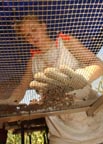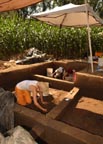August 17, 2005
Archaeologists make new finds at Kincaid Mounds
CARBONDALE, Ill. -- Work this summer by archaeologists at Southern Illinois University Carbondale suggests a well-known prehistoric mound site dating back nearly 1,000 years is larger and possibly more complex than originally believed.The investigation at Kincaid Mounds shows a new prehistoric platform mound between 250 and 300 yards outside of known defensive walls around the site. SIUC students participating in the annual eight-week field school by the University's Department of Anthropology and Center for Archaeological Investigations focused on excavating the previously undefined West Mound area, where geophysical studies in November also indicated the possible existence of numerous nearby houses buried under alluvium.
"At some moment in its history this site was considerably larger than we had expected or it is considerably more complex with distinct parts of it in different locations," said Paul D. Welch, an associate professor in anthropology.
Located in Massac and Pope counties, Kincaid Mounds is one of the largest prehistoric – before written documentation – Native American sites in Illinois, and the seventh or eighth largest site of its time period in the eastern United States. Native Americans occupied the site beginning around A.D. 1000 but abandoned it for still-unknown reasons by about A.D. 1450, several hundred years before French explorers arrived. Kincaid was one of the two major political centers of the Mississippian period in the lower Ohio Valley. The Illinois Historic Preservation Agency owns about two-thirds of the Kincaid Mounds site in Massac County, while the remaining property in Pope County is in private ownership.
This summer's project greatly expanded on work initially done in the 1930s and early 1940s by the University of Chicago, said Brian M. Butler, director of SIUC's Center for Archaeological Investigations and an adjunct anthropology professor. The work begun 70 years ago was "very good and extremely important in the development of American anthropology; it was only one of two places at that time that were training archaeologists in the country," he said.
The new discovery, aided by technology unavailable 70 years ago, indicates there is a "whole series of lesser mounds that is part of the complex on state land that Chicago never looked at," Butler said.
With all good archaeology, "it's the question that drives the research," he said.
SIUC proposed to state officials to determine whether a "bump" in the current corn field was a prehistoric mound that dates to the same time period of the site's occupation, was built much later, or is a natural land form.
The state leases its property for no-till farming. After last fall's harvest, a scan of the area with a magnetometer -- which measures minute variations in the earth's magnetic field -- revealed surprising data prompting this summer's work. Fieldwork performed to this point shows two prehistoric houses in addition to the western mound.
Welch and Butler say radiocarbon testing will further determine when the houses were built and the mound constructed. Burned grass thatch uncovered in the excavations "will give us an extraordinarily good date for the beginning of mound construction," within a five to 10 year time frame, Welch said. A third nearby excavation area yielded a carved stone pipe in the effigy of a bird.
Little work was done with Kincaid after World War II until the late 1960s. That's when SIUC anthropology professor emeritus Jon Muller did small-scale salvage work in an area bulldozed by the property owner prior to state ownership, and survey work was also conducted in adjacent areas in 1970s and early 1980s.
Confirming there is a settlement on the western side of Kincaid Mounds seems to "balance off" the eastern part of the complex, said Butler. As one of Muller's students in the 1970's, he performed intensive survey work and excavations documenting supporting populations near Kincaid Mounds.
"We felt it was time to go back to the Kincaid site itself and start doing some new work," he said. "We have most of the collections and records from the Chicago work here and it was as we began to look those that it began to raise new questions."
A group of 11 undergraduate and graduate students spent a good portion of the field school, which ended Aug. 5, working in areas surrounded by eight-foot-tall corn and in temperatures that at times climbed above 100 degrees. The field school site in Massac County is about one mile from the Ohio River near Brookport, about 75 miles southeast of Carbondale.
For Tamira K. Brennan, a graduate student in anthropology, the work opened up the past and offered a glimpse of building architecture.
"I think it's really exciting because not a lot of work here has been done since the 1930's and it's nice to be able to open it up and see what is out here, especially with modern field techniques," said Brennan, 25, of Crete.
Welch noted almost no archaeology work has been done at Kincaid in 60 to 70 years.
"We have learned a lot about the prehistory of this entire region in those intervening decades and it is now an opportunity for us to come back to this important site … and do much more sophisticated, much more careful work now than they knew how to do at that time."
The field school is a way to answer archaeological research questions, addressing government agency land-management issues, and training students how to excavate – all in a single project, Welch said.
"The only way you can really learn to be an archaeological excavator is to participate on an excavation and have hands-on experience," he said. "Reading about it, hearing lectures in the classroom is just not the same. You have to have your hands in the dirt."
Results of this summer's excavation will form the basis of a presentation planned for early November at a conference in Columbia, S.C., and the state's historic preservation agency will receive a report as well. It will then be up to the state agency to determine if it wants to take the land out of cultivation, Welch said.
"We hope we are on the beginning early phases of work," Butler said, noting that the IHPA provided a small amount of money to cover transportation costs, but the fieldwork was largely at the University's expense.
Leading in research, scholarly and creative activities and offering progressive graduate education are among the goals of Southern at 150: Building Excellence Through Commitment, the blueprint for the development of the University by the time it celebrates its 150th anniversary in 2019.
For more information on the Kincaid Mounds project contact Brian M. Butler, director of the Center for Archaeological Investigations at 618/453-5031 or associate professor Paul D. Welch at 618/453-4740.
Caption 1: Archaeology
After a closer examination – Bridgett A. Williams, a junior majoring in anthropology from Springfield, sifts through dirt dug from an excavation site at Kincaid Mounds in Massac County near the Ohio River. Williams was one of 11 Southern Illinois University Carbondale students participating in an eight-week field school this summer that uncovered a previously unknown mound and prehistoric residences at the site. Williams is looking for pottery fragments left behind by Native Americans who occupied the site from approximately A.D. 1000 to about A.D. 1450.
Photo by Jeff Garner
Caption 2: Archaeology
Surveying the area –Three of the students participating in Southern Illinois University Carbondale’s summer 2005 field school take great care while excavating remains of a Native American home in a previously unknown area of Kincaid Mounds last month. Eleven students participated in the field school offered by the University’s Center for Archaeological Investigations.
Photo by Jeff Garner


